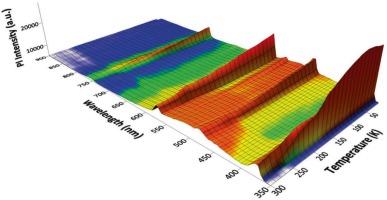静电纺PVA@ZnO:xDy3+纳米纤维白光发射的光谱和形态特性
IF 5.1
3区 工程技术
Q1 CHEMISTRY, APPLIED
引用次数: 0
摘要
在本研究中,采用沉淀法分别以1、2、3、5、7%的质量分数加入Dy3+,制备了ZnO:Dy纳米粒子,并用粉末XRD技术对其进行了结构分析。将所得的ZnO:Dy3+纳米颗粒掺入PVA聚合物基体中,利用静电纺丝技术制备PVA@ZnO:xDy3+ (x = 0,1,2,3,5和7wt %)纳米纤维。利用傅里叶变换红外光谱(FTIR)、固态紫外吸收光谱、场发射扫描电子显微镜(FESEM)、热重分析(TGA)和光致发光(PL)光谱等多种技术对PVA@ZnO:xDy3+纳米纤维进行了表征,以揭示其结构、形态、热学和光学性质。为了解Dy3+离子掺杂对发光行为的影响而进行的PL研究表明,纯纳米纤维发出绿蓝色光,而Dy3+掺杂PVA@ZnO:xDy纳米纤维发出接近白色的光。Dy3+离子以其特有的蓝黄色发光而闻名,当这些发光的强度比优化时,可以产生白光,在本研究中,达到PL强度最大值的Dy3+掺杂浓度为2 wt%时的CIE坐标为0.3004;0.3302,非常接近白光的理想值(0.333;0.333)。由于这一特性,所获得的光纤可能是设计和生产白光发光器件的有吸引力的候选者。本文章由计算机程序翻译,如有差异,请以英文原文为准。

Spectroscopic and morphological properties of white light emitted electrospun PVA@ZnO:xDy3+ nanofibers
In this study, ZnO:Dy nanoparticles were obtained using the precipitation technique by adding Dy3+ at 1, 2, 3, 5, and 7 % by weight and structurally analyzed by the powder XRD technique. The resulting ZnO:Dy3+ nanoparticles were incorporated into a PVA polymer matrix to produce PVA@ZnO:xDy3+ (x = 0, 1, 2, 3, 5, and 7 wt%) nanofibers by using the electrospinning technique. The PVA@ZnO:xDy3+ nanofibers were characterized using various techniques, including Fourier Transform Infrared (FTIR) spectroscopy, solid-state UV absorption spectroscopy, field emission scanning electron microscopy (FESEM), thermogravimetric analysis (TGA), and photoluminescence (PL) spectroscopy to reveal the structural, morphological, thermal, and optical properties. PL studies performed to understand the effect of Dy3+ ion doping on the luminescent behavior show that while the pure nanofibers emit greenish-blue light, the Dy3+-doped PVA@ZnO:xDy nanofibers emit light close to white. Dy3+ ions, known for their characteristic blue and yellow emissions, can produce white light when the intensity ratio of these emissions is optimized, and in this study, the CIE coordinates for the 2 wt% Dy3+ doping concentration at which the PL intensity maximum is reached are 0.3004;0.3302, which is very close to the ideal value of white light (0.333;0.333). Due to this feature, the obtained fibers may be an attractive candidate for the design and production of white light-emitting devices.
求助全文
通过发布文献求助,成功后即可免费获取论文全文。
去求助
来源期刊

Reactive & Functional Polymers
工程技术-高分子科学
CiteScore
8.90
自引率
5.90%
发文量
259
审稿时长
27 days
期刊介绍:
Reactive & Functional Polymers provides a forum to disseminate original ideas, concepts and developments in the science and technology of polymers with functional groups, which impart specific chemical reactivity or physical, chemical, structural, biological, and pharmacological functionality. The scope covers organic polymers, acting for instance as reagents, catalysts, templates, ion-exchangers, selective sorbents, chelating or antimicrobial agents, drug carriers, sensors, membranes, and hydrogels. This also includes reactive cross-linkable prepolymers and high-performance thermosetting polymers, natural or degradable polymers, conducting polymers, and porous polymers.
Original research articles must contain thorough molecular and material characterization data on synthesis of the above polymers in combination with their applications. Applications include but are not limited to catalysis, water or effluent treatment, separations and recovery, electronics and information storage, energy conversion, encapsulation, or adhesion.
 求助内容:
求助内容: 应助结果提醒方式:
应助结果提醒方式:


